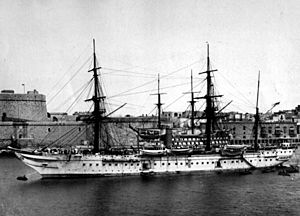HMS Tamar (1863) facts for kids

HMS Tamar at Malta, 1882
|
|
Quick facts for kids History |
|
|---|---|
| Name | HMS Tamar |
| Builder | Samuda Brothers |
| Launched | June 1863 |
| Fate | Scuttled off old Wan Chai Ferry Pier (near today's Hong Kong Convention and Exhibition Centre), Hong Kong, 12 December 1941 |
| General characteristics | |
| Type | Troopship |
| Displacement | 4,650 tons |
| Tons burthen | 2,812 bm |
| Length | 320 ft (98 m) |
| Beam | 45 ft (14 m) |
| Propulsion | 1 propeller; 500 hp (373 kW) steam plant |
| Sail plan | Barque rigged |
| Speed | 12 knots (22 km/h; 14 mph) |
| Armament | 3 guns |
HMS Tamar was a ship that carried soldiers for the Royal Navy, which is Britain's navy. She was built in London, England, and launched in 1863. Later, from 1897 to 1941, she became a supply ship. Her name was even given to a naval base in Hong Kong, called HMS Tamar, which operated from 1897 to 1997.
Contents
The Story of HMS Tamar
Early Life and Voyages
HMS Tamar was actually the fourth ship to have this name. It came from the River Tamar in Cornwall, England. The ship's special symbol was also based on the river's coat of arms.
The ship was built in Cubitt Town in East London. She was launched in June 1863. Her very first trip began on January 12, 1864. She sailed as a troopship, carrying soldiers to places like the Cape in South Africa and China.
During her travels, Tamar had a few accidents. On December 13, 1866, she got stuck in shallow water near Haulbowline, County Cork in Ireland. Luckily, she was refloated a few days later on December 17. Then, on October 18, 1869, she ran aground again near Paul's Island in Newfoundland Colony.
Ship Design and Power
Tamar was a special ship because she had two ways to move. She had tall masts and sails, like old sailing ships. But she also had a steam engine with a propeller. This allowed her to reach a speed of about 12 knots (about 22 kilometers per hour).
Originally, she had two funnels to let out smoke from her engines. But later, she was updated with a more modern boiler. This change meant she only needed one funnel.
Helping in Wars
Tamar played a part in several important events. In 1874, she was part of the Naval Brigade. This group of sailors helped to defeat the Ashanti in West Africa during the Ashanti War.
She had more grounding incidents in 1875. On April 7, she ran aground while leaving Kingstown, County Dublin. She was refloated and continued her journey. A few days later, on April 15, she ran aground again at Chatham, Kent. She was pulled free with help.
On November 7, 1876, Tamar was pushed ashore by strong winds near St. Catherine's Point in Bermuda. She was on her way from England to Bermuda. Her soldiers were safely taken off the ship. She was refloated about 12 hours later.
Tamar also took part in the Zulu War in 1879. Later, in 1882, she was involved in events off the coast of Egypt.
A Strange Incident
In 1879, a newspaper called The British Medical Journal reported something unusual. A group of sailors on Tamar got sick after eating a bad pigeon pie. This led to an investigation by the British Admiralty, which was in charge of the Royal Navy.
Becoming a Base Ship
In 1897, Tamar was no longer used as a regular ship. She became a "hulk," which means she was used as a floating base or storage ship. She took over from another ship, HMS Victor Emmanuel, as the main receiving ship in Hong Kong.
She served as this base ship until a new naval station was built on land. This new land base was also named HMS Tamar, carrying on the ship's name.
Final Days in World War II
During World War II, the Battle of Hong Kong began. On December 8, 1941, Tamar was towed out to a special buoy (a floating marker) in the water.
As the Imperial Japanese forces attacked Hong Kong, orders came on December 11 to sink the ship on purpose. This is called "scuttling." Tamar was scuttled at the buoy on December 12, 1941. This was done to stop the invading Japanese forces from being able to use the ship.
However, the ship's upper parts filled with air, making it hard for her to sink right away. So, the Royal Artillery (a part of the army) had to fire cannons at her to make sure she sank completely.
Legends and Discovery
Over the years, some stories have been told about Tamar. One legend says that a mast from the ship was put up outside Murray House in Stanley. Another story claims that wooden planks from the ship were used to make the main doors of St. John's Cathedral in Central district. However, people have questioned if these stories are true.
In late 2014, something exciting happened. Workers were digging for a new road project called the Central–Wan Chai Bypass. They found the remains of a ship that looked very much like Tamar. It was found exactly where she was believed to have been scuttled, near the old Wan Chai Ferry Pier. A government report in 2017 confirmed that there is strong evidence these remains are indeed those of HMS Tamar.
Images for kids
-
The anchor believed to be from HMS Tamar, now at the Hong Kong Museum of Coastal Defence



